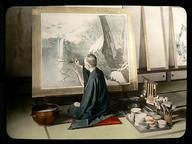Quiz Answer Key and Fun Facts
1. This milk-white bull is the mythical ride of the god Shiva. What is the name of this pale beast?
2. What is the name for the little 'toggle' devise worn on the obi (sash) of a Japanese kimono?
3. A Japanese term for the Buddha, it is derived from the Sanskrit 'tathagata' (meaning 'come this way') and is used to describe the Buddha as depicted in a simple priest's robe, with one arm and half his upper body uncovered in sculpture. What is this term?
4. Chinese ink (mo) is divided into two types: 'nen-mo' and 'lao-mo'. 'Lao-mo', or 'old ink' is used for showing surface lines and creating a vague atmosphere on the canvas. 'Nen-mo' is used to create freshness and a certain luminosity with the painting. To what do you think 'nen' translates into English?
5. Which of these is the Buddhist term for god or spirit?
6. One of these is a Japanese drama style, but which?
7. One can't look through much Hindu art without coming across Nagas. What type of creatures are the Nagas?
8. Calligraphy is the chief art of Chinese history, more well esteemed even then painting. The term 'Nu-shu' is used to describe someone who mindlessly follows the work of only one previous master. What does the term 'nu' translate to in English?
9. What is the term for 'Japanese-style' painting, as opposed to the western-style oil painting called 'Yoga', that was championed by Ernest Fenollosa during his appointment at the University of Tokyo in the late 19th century?
10. What is the Buddhist term for 'extinction' or 'snuffing out', the final release from the earthly life?
Source: Author
thejazzkickazz
This quiz was reviewed by our editing team before going online.
Any errors found in FunTrivia content are routinely corrected through our feedback system.
